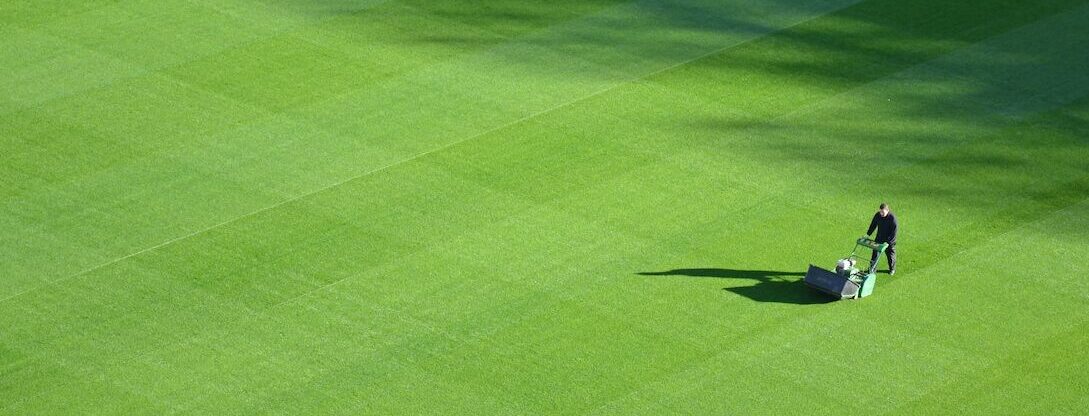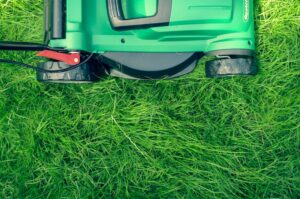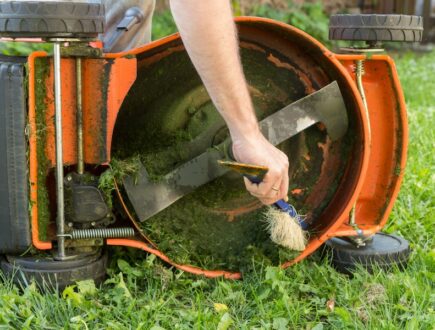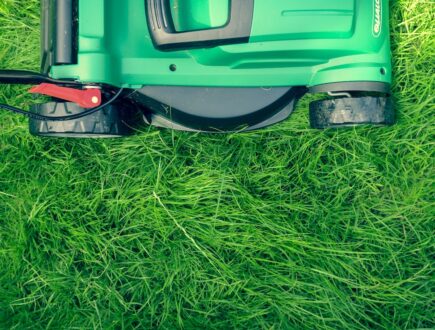Log in or create new account to save this product to your wishlist.

Lawn Mowing: Why, When & How Often You Should Do It
When and how often should you mow the lawn? What is the ideal cutting height? Which mower should you use? Find answers to these questions and more here.
🌱 All important maintenance moments for your lawn during the year. Leave your email and we will send you the lawn calendar for free.
Enter your email
Receive the lawn calendar in the mail
Enjoy a green lawn all year round!

- Order by 2PM = shipped today
- 250.000+ satisfied customers!
- 60 day satisfaction guarantee
Lawn mowing might feel like a chore, but if you want a lawn that you’re proud of, you need to mow. In fact, lawn mowing is probably the most crucial of all regular lawn care tasks.
But there’s an art to effective mowing. When and how often should you mow? What is the ideal cutting height for your grass? Which mower should you use?
- Why is it important to mow your grass?
- Lawn mowing – when to mow
- How often should you mow your lawn?
- What is the ideal cutting height for the grass?
- The first mowing of a new lawn
- How do you mow stripes into your lawn?
- Mulching or removing grass clippings
- Which type of lawn mower should I use?
- How do you maintain your lawnmower?
- Lawn Mowing: 8 tips for a beautiful lawn
We’ve got answers to all of those questions , and more. So, before you get the mower out, put your feet up. Here are our favourite tips for a beautiful and sleek lawn.
Why is it important to mow your grass?

You probably mow your lawn to keep it looking neat, but there are more good reasons to maintain your turf. Firstly, it strengthens your lawn. Sunlight and oxygen can penetrate the soil more effectively, promoting the growth of new grass.
By mowing regularly, all grass blades, including the finer ones, get the chance to become large and sturdy. This helps create a lush, dense lawn. Another advantage is that frequent mowing reduces or eliminates the chances for moss and weeds to thrive.
Lawn mowing – when to mow
Always mow when the grass is completely dry. Mowing on wet grass will result in inefficient cutting of the blades. Moreover, grass can accumulate in the mower, leading to potential clogging.
Mowing on damp grass also provides a more favourable environment for the spread of fungi and diseases. Ensure it’s not too warm and avoid mowing in direct sunlight. The optimal time for mowing is in the late afternoon, allowing the grass sufficient time to recover before nightfall.
How often should you mow your lawn?
How often you should cut the grass is determined by its growth speed. Rapid growth? Aim for mowing twice a week. If it’s growing at a slower rate, once a week will do the job.
What is the ideal cutting height for the grass?

Generally, it is recommended to mow your lawn between 2.5 and 4 cm. If the lawn is heavily used, such as by playing children, it is advisable to mow it slightly longer, between 4 and 5 cm.
If your lawn is predominantly in the shade, consider mowing it at a height of 7 cm. This way, the plant has more leaves to capture light and produce nutrients.
Always keep the 1/3 rule in mind: mow a maximum of one-third of the grass length to preserve its growth vigour.
The first mowing of a new lawn
Have you recently established a new lawn? Then wait for two weeks before mowing it for the first time. This allows the grass sods to root, creating a firm foundation for your lawn. Set the mower to the highest setting during the initial mowing.
Mow a maximum of 1/3 of the grass blades during the first mowing. If you desire a shorter grass length, wait a few days and mow another 1/3 of the grass. Repeat this process until you reach the desired height.
How do you mow stripes into your lawn?
Fancy achieving those charming stripes on your lawn, just like those at Wimbledon? Your lawn can capture the same allure!
You’ll need a cylinder mower with rollers at the front and the back of the cutting cylinder. The front roller is usually grooved, which helps line the grass up for even cutting. The back roller presses the grass down in a single direction. You achieve the stripes by mowing up the lawn in a straight line.
Et voilà: Wimbledon stripes in suburbia.
Mulching or removing grass clippings
Mulching involves shredding the mowed grass and leaving it on the lawn, returning nutrients to the turf. One advantage is the absence of mowing waste, eliminating the need to empty your mower’s collection bin. In summer, it provides an additional protective layer for your lawn. Mulching essentially applies a felt layer to the grass, requiring more frequent scarifying.
However, mulching isn’t suitable if the grass is too long, as it can lead to a thick layer that suffocates the grass. Convinced that mulching is right for you? Make sure to use a mower with a mulching kit. If you prefer collecting the cut grass in a bin, that’s no problem! Just ensure you have a well-established fertilisation plan to provide adequate nutrition to your lawn.
Which type of lawn mower should I use?
Learn about the different types of lawn mowers and find the one that suits your needs.

Hover mowers
Hover mowers have a single blade that spins at speed, creating an air pocket beneath the body of the mower, which causes the whole unit to hover slightly. Most hover mowers are electric, but you can also choose petrol- or battery-powered.
Cylinder mowers
Cylinder mowers contain a reel of spiralised cutting blades. When pushed, the grass is caught between the spiral cylinder and an additional straight cutting blade, making a clean cut. Cylinder mowers are powered by electricity, petrol, diesel, or batteries.
Manual push mower
If you have a smaller lawn, you might consider a manual push mower – a cylinder mower that’s powered by pushing. This option is far more physically demanding than powered machines, but there are no cables and you don’t need to buy petrol. These machines make very little noise.
Ride-On Mower
Ride-On mowers are perfect for large gardens and are great fun to use. These tend to have a much wider cutting deck and are capable of excellent striping. These machines are usually petrol-powered, although some are available with car battery-style cells that are rechargeable.
Robotic Lawnmower
Robot lawnmowers are the ultimate in convenience, but they come with a price tag. On the other hand, it could be a good investment because you’ll never have to cut your lawn by hand ever again.
How do you maintain your lawnmower?
Whichever machine you use, they all require maintenance. Remove mud and grass residues after each use. For prolonged enjoyment of your mower, store it in a dry place. Give your mower a comprehensive service at least once a year.
Lawn Mowing: 8 tips for a beautiful lawn
Discover how to achieve the perfect lawn quickly and easily with these 8 tips.
Tip #1: Always mow with sharp blades
For a clean-cut, mow your grass with sharp blades. Blunt blades tear the grass, which dries out the plant and leaves the grass blades open to infection and disease.
Tip #2: Mow weekly in the spring and summer
Grass grows faster in the spring and summer. By mowing weekly, you’ll keep your lawn in tip top condition!
Tip #3: Only mow when the grass is dry
Wet grass tears, so ensure that the grass is dry before you mow. This benefits the quality of your grass and is better for your cutting blades.
Tip #4: Do not mow when it is too cold
The best temperature for mowing grass is between 12 and 20 degrees. Mowing when it’s too cold will damage the plant.
Tip #5: Always take The 1/3 rule into account
Cut up to a third of the grass length at a time. This way, the grass retains its vigour.
Tip #6: Mow in different directions
Varying the direction and pattern of cutting each time you mow helps your grass grow straighter and healthier.
Tip #7: Maintain your mower during the winter
Replace the oil, air filter, and spark plugs if your mower has them. Lubricate all moving parts and ensure that the blades are sharpened. This way, your mower is ready for the new mowing season!
Tip #8: Trim the edges of your lawn.
Don’t forget to cut and trim the edges of your lawn for the neatest look. Use a strimmer or a manual edger to cut crisp lines.
Ready to get started?
Interested in mastering the art of lawn mowing or perfecting your garden care? Craft your ideal outdoor haven with our expert tips! Should you have any inquiries, don’t hesitate to reach out – we’re here to help.
Happy mowing!
-
The Best Lawn Mower Maintenance Tips & ChecklistProper lawn mower maintenance is crucial to extend its lifespan, and you'll also save on repair costs. Learn how to keep this helper performing at its best.Read more
-
The Pros and Cons of a Robot LawnmowerNot all robots are out to take over the planet (or steal our jobs). Some robots are here to take the hassle out of mowing. Find out the pros and cons of these convenient gadgets.Read more
-
Can You Cut Wet Grass?To mow or not to mow when the grass is still wet? It's a tricky one, but there are ways to ensure you don't kill your lawn.Read more
-
How to Sharpen Your Lawn Mower Blades: An Ultimate GuideCutting your lawn with blunt blades leaves your grass plants open to diseases and pets. Sharpening lawn mower blades is a relatively simple DIY task. Find out how.Read more
Leave a comment
Your answer will be displayed on the site and the interested party will be notified by email.
Leave a comment
Have a question or want to share your experience? Leave us a comment.

- Order by 2PM = shipped today
- 250.000+ satisfied customers!
- 60 day satisfaction guarantee

- Order by 2PM = shipped today
- 250.000+ satisfied customers!
- 60 day satisfaction guarantee

🌱 All important maintenance moments for your lawn during the year. Leave your email and we will send you the lawn calendar for free.
Enter your email
Receive the lawn calendar in the mail
Enjoy a green lawn all year round!


















Comments (0)
There are no comments yet. Well then, what are you waiting for to
Be the first to write your comment!inaugurate this pretty page?
Do you have some comments?